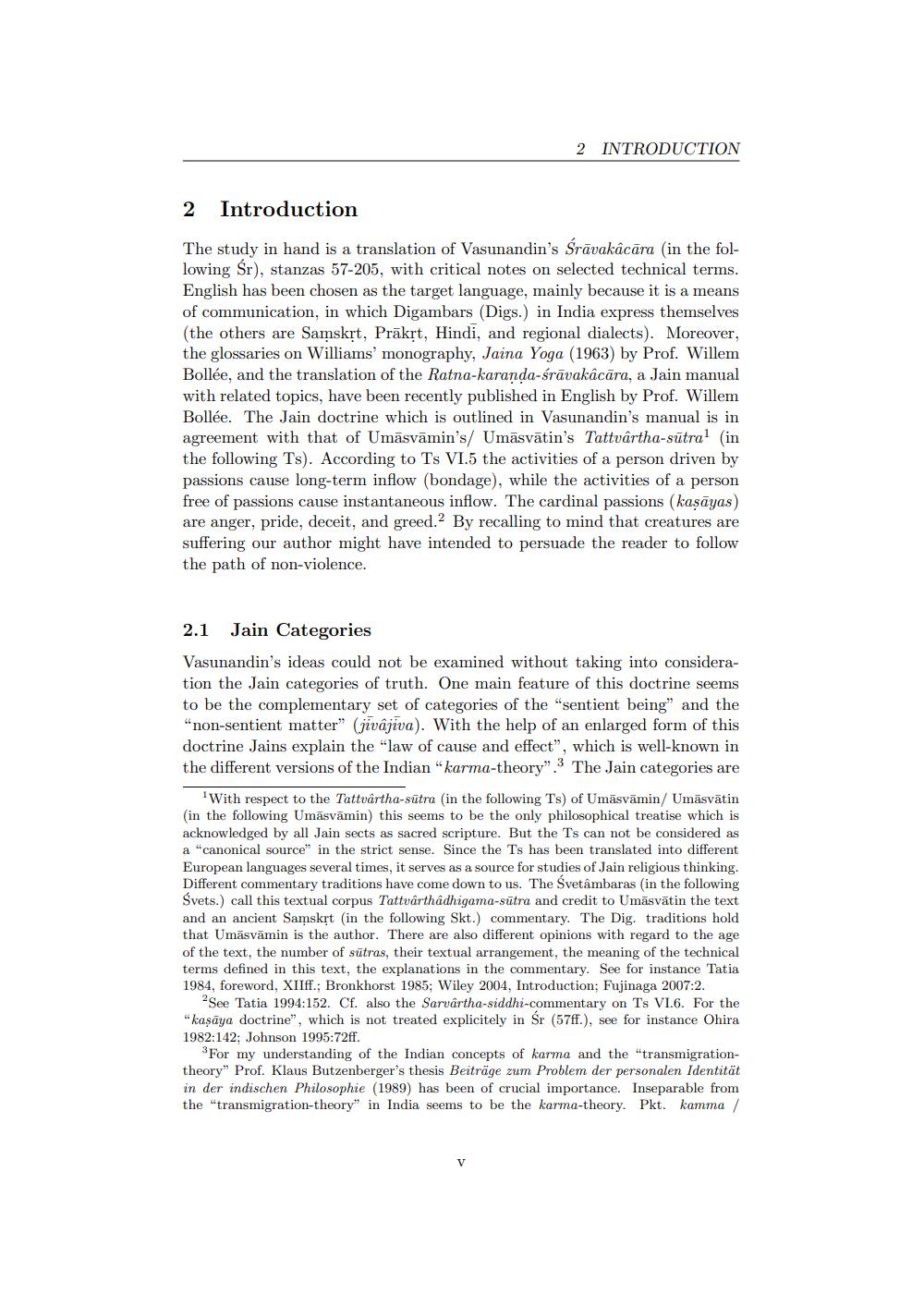Book Title: Shravakachar of Vasunandini Author(s): Signe Kirde Publisher: Signe Kirde View full book textPage 7
________________ 2 INTRODUCTION 2 Introduction The study in hand is a translation of Vasunandin's Srāvakâcāra (in the following Sr), stanzas 57-205, with critical notes on selected technical terms. English has been chosen as the target language, mainly because it is a means of communication, in which Digambars (Digs.) in India express themselves (the others are Samskrt, Prākrt, Hindi, and regional dialects). Moreover, the glossaries on Williams' monography, Jaina Yoga (1963) by Prof. Willem Bollée, and the translation of the Ratna-karanda-śrāvakâcāra, a Jain manual with related topics, have been recently published in English by Prof. Willem Bollée. The Jain doctrine which is outlined in Vasunandin's manual is in agreement with that of Umāsvāmin's/ Umāsvātin's Tattuârtha-sūtrat in the following Ts). According to TS VI.5 the activities of a person driven by passions cause long-term inflow (bondage), while the activities of a person free of passions cause instantaneous inflow. The cardinal passions (kasāyas) are anger, pride, deceit, and greed.By recalling to mind that creatures are suffering our author might have intended to persuade the reader to follow the path of non-violence. 2.1 Jain Categories Vasunandin's ideas could not be examined without taking into consideration the Jain categories of truth. One main feature of this doctrine seems to be the complementary set of categories of the "sentient being and the "non-sentient matter" (jivajiva). With the help of an enlarged form of this doctrine Jains explain the "law of cause and effect", which is well-known in the different versions of the Indian "karma-theory" 3 The Jain categories are With respect to the Tattvartha-sūtra (in the following Ts) of Umāsvāmin/ Umāsvātin (in the following Umāsvāmin) this seems to be the only philosophical treatise which is acknowledged by all Jain sects as sacred scripture. But the Ts can not be considered as a "canonical source in the strict sense. Since the Ts has been translated into different European languages several times, it serves as a source for studies of Jain religious thinking. Different commentary traditions have come down to us. The Svetâmbaras in the following Svets.) call this textual corpus Tattvarthâdhigama-sútra and credit to Umāsvātin the text and an ancient Samskrt in the following Skt.) commentary. The Dig. traditions hold that Umāsvāmin is the author. There are also different opinions with regard to the age of the text, the number of sūtras, their textual arrangement, the meaning of the technical terms defined in this text, the explanations in the commentary. See for instance Tatia 1984, foreword, XIIff.; Bronkhorst 1985; Wiley 2004, Introduction; Fujinaga 2007:2. See Tatia 1994:152. Cf. also the Sarvartha-siddhi-commentary on Ts VI.6. For the "kaşāya doctrine”, which is not treated explicitely in Śr (57ff.), see for instance Ohira 1982:142; Johnson 1995:72ff. 3 For my understanding of the Indian concepts of karma and the "transmigrationtheory" Prof. Klaus Butzenberger's thesis Beiträge zum Problem der personalen Identität in der indischen Philosophie (1989) has been of crucial importance. Inseparable from the "transmigration-theory" in India seems to be the karma-theory. Pkt. kamma/Page Navigation
1 ... 5 6 7 8 9 10 11 12 13 14 15 16 17 18 19 20 21 22 23 24 25 26 27 28 29 30 31 32 33 34 35 36 37 38 39 40 41 42 43 44 45 46 47 48 49 50 51 52 53 54 55 56 57 58 59 60 61 62 63 64 65 66 67 68 69 70 71 72 ... 187
